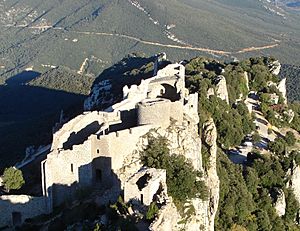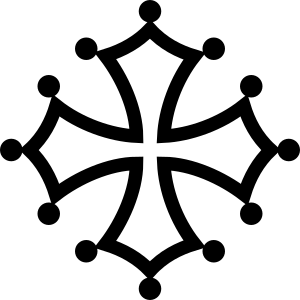Catharism facts for kids

The Cathars were a group of Christians who lived in parts of Europe, especially in southern France, during the Middle Ages. Their beliefs were different from the main Catholic Church. The word 'Cathar' comes from a Greek word, katharos, which means "pure" or "unpolluted".
Contents
What Cathars Believed
Cathars had some unique beliefs about the world. They thought that there were two main powers: a good god and a bad god. They believed the bad god created the physical world we live in. They thought that people's spirits were from the good god, but they were trapped in bodies by the bad god.
They also believed in reincarnation. This means that when someone died, their spirit would be reborn into a new body. Cathars thought this cycle could be broken through a special cleansing ritual. They did not believe in the idea of sin in the same way other Christians did.
Their Way of Life
Cathars were known for being pacifists, meaning they did not believe in fighting. They also had strict rules about what they ate. They avoided most animal products, like meat and milk. However, they did eat fish. They believed fish were not truly alive in the same way other animals were.
Women played an important role in the Cathar faith. They could become leaders and teachers, which was unusual for the time. Cathars also used a Bible translated into the local language that people spoke every day. This was different from the Catholic Church, which mostly used the Bible in Latin, a language only priests understood.
Problems with the Catholic Church
The Cathar faith grew quite popular in southern France, especially in a region called the Languedoc. This area was different from other parts of Europe. Peasants often owned their own land, and there was a growing group of merchants and bankers. This made the region more independent.
The Catholic Church saw Catharism as a heresy. This meant they believed Cathar teachings were wrong and went against true Christian beliefs. In 1145, the Church began to openly challenge the Cathars. Cathars, in turn, criticized the Catholic Church, saying it was corrupt.
Church Reactions
The Catholic Church tried to stop the spread of Catharism. In some places, like England and northern France, Cathars were quickly put down. But in southern France, many local nobles protected the Cathars. This made it harder for the Catholic Church to control the situation there.
Historians believe that the conflict was not just about religion. It was also about power and land. The French king and some northern nobles wanted to take control of the wealthy southern lands. The Cathar movement gave them a reason to attack.
The Albigensian Crusade
To deal with the Cathars, the Pope ordered a special crusade against them. This was called the Albigensian Crusade. It was named after the town of Albi, a Cathar stronghold. The Pope promised the crusaders the same rewards as those who fought in the Holy Land, including forgiveness for all their sins.
Brutal Methods
In July 1209, a large army of about 30,000 crusaders arrived at the town of Béziers. They demanded that the town hand over about 200 Cathars. But the people of Béziers, many of whom were Catholic, refused to betray their friends and family.
During the attack on Béziers, the crusaders killed everyone in the town. A famous, but terrible, quote from the leader, Arnauld Amaury, was: "Kill them all, God knows his own." This meant they should kill everyone, and God would sort out who was Catholic and who was Cathar. It is thought that about 20,000 people were killed, including many Catholics.
The crusade continued for over 40 years. In 1210, at the fortress of Minerv, the crusaders started the practice of burning people at the stake who were considered heretics. This cruel method was later used by the Inquisition, a Church court set up to find and punish heretics.
The End of Catharism
The Albigensian Crusade severely weakened the Cathar movement. Many Cathars were killed, and their strongholds were destroyed. The last known Cathar leader in the Languedoc region, Guillaume Bélibaste, was killed in 1321. After this, Catharism slowly disappeared from Europe.
Images for kids
-
War in heaven. Illustration by Gustave Doré.
-
St. Paul, by Valentin de Boulogne.
-
The Fall of the Rebel Angels by Hieronymus Bosch.
-
Painting by Pedro Berruguete showing a story where Saint Dominic's books were saved from a fire during a debate with Cathars.
-
Cité de Carcassonne in 2007.
See also
 In Spanish: Catarismo para niños
In Spanish: Catarismo para niños








